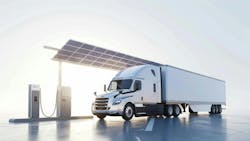Charging ahead: How a phased approach can mitigate fleet electrification challenges
The electrification of heavy-duty trucks is generating a sense of cautious optimism, much like the early days of cloud computing. While the long-term benefits of a clean and efficient transportation system are evident, concerns linger about the initial costs and the need for a robust charging infrastructure.
This article proposes a strategic, step-by-step approach to EV adoption for fleets, recognizing that electrification is a journey, not a single destination. Each incremental step forward benefits the industry as a whole. Infrastructure providers must meet fleets where they are in the transition process, making the electrification transition as seamless as possible and collectively unlocking EVs' environmental and economic advantages.
Breaking down a phased approach for heavy-duty electrification
Replacing an entire fleet of HD trucks with EVs is a tall order that will incur significant costs. Rather than overhauling a fleet in one fell swoop, fleet managers should be guided to transition gradually, taking small yet impactful steps toward electrification over time. This phased approach involves more than just incrementally increasing the number of electric trucks; it also addresses the development of charging infrastructure.
Dividing the transition into stages allows fleets to approach electrification methodically. With a phased approach, fleets can start by building charging at their facilities for the small number of EVs they initially acquire. As the number of EVs grows, the strategy can gradually shift towards leveraging a combination of on-site as well as offsite charging through the help of specialized infrastructure providers. This network effect maximizes charging efficiency as the fleet scales electrification efforts.
As fleets transition HD trucks bit by bit and work toward building a charging network, upfront costs are spread out, and experience with EVs can be gained before making a total commitment. In a phased approach, strategic prioritization is vital; focus on which lanes are best suited for electrification. For example, shorter haul routes best suited to existing HDEV truck ranges and charging availability are an optimal place to start and will help to maximize the return on investment in the initial stages.
See also: Scaling charging infrastructure: Where to begin
Why a phased approach matters for your bottom line
For fleets that work with EV charging infrastructure partners from the beginning, including for their on-site charging needs, benefit from having to put up little to no upfront capex, thereby spreading out the costs of electrification over time.
This is particularly important considering the current price premium on EVs compared to traditional gasoline or diesel-powered vehicles; a recent EESI report states that electric trucks can be 2-3 times more expensive upfront than their diesel counterparts without the support of grant funding.
Being agile in a dynamic landscape
Beyond the financial advantages, a phased approach allows fleets to adapt to a rapidly evolving EV landscape. Investment in technological advancements and innovation within the EV sector will continue accelerating, bringing new battery capabilities, increased charging speeds, and expanded vehicle ranges to market.
With a phased transition, fleets can continuously stay informed about the latest advancements, prioritize investments, and implement changes that deliver the most ROI over time. As technology matures, fleet owners can be assured that they are maximizing the transition's benefits in the most efficient way possible.
For instance, a fleet might initially invest in fewer EVs with shorter ranges that are suitable for their current needs. As battery technology progresses, they can strategically upgrade their fleet with newer models boasting longer ranges. This phased approach allows them to leverage technological advancements without incurring significant upfront costs for cutting-edge technology.
See also: Is the U.S. power grid ready for electrification?
Ecosystem collaboration is key
Discussions on fleet electrification tend to focus on immediate cost burdens and infrastructure limitations. Reframing the transition as a collaborative journey toward zero-emission transportation is crucial.
The electrification paradigm shift requires the entire transportation ecosystem to work together. A comprehensive approach involving technological innovation, policy support, and collaboration among stakeholders, including utilities, regulators, automakers, charging infrastructure providers, and consumers, is critical to accomplishing carbon reduction goals.
A phased approach is essential in today’s landscape to offer practical solutions that can scale over time—a win-win situation. Financial tools like grants and leasing options coupled with innovative solutions like battery subscriptions further bridge the cost gap between electric and traditional vehicles and provide predictable monthly payments. For example, in January, the Biden administration announced over $620 million in grant funding to help counties, cities, and tribes nationwide install new charging stations for electric vehicles and long-haul freight trucks.
A shift made possible by incremental steps
Fleet electrification represents a monumental shift in the transportation landscape, one that promises to revolutionize how we move goods and people. While we must acknowledge the myriad of obstacles facing us on the road to zero-emission transport, there is nothing insurmountable with investment in innovation and collaboration among stakeholders.
With each step forward, fleets move closer to a future where sustainability and profitability go hand in hand.
About the Author

Justin Turner
Justin Turner is the chief commercial officer at Terawatt where he oversees global revenue, marketing, customer success, and channel partnership functions. He has more than a decade of experience, with previous leadership roles at Coyote Logistics (now UPS) and GlobalTranz (now Worldwide Express).
